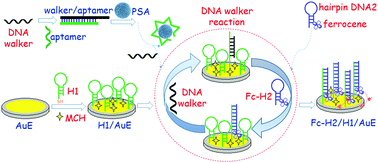DNA walker-amplified signal-on electrochemical aptasensors for prostate-specific antigen coupling with two hairpin DNA probe-based hybridization reaction
Abstract
Electrochemical aptasensing systems have been developed for screening low-abundance disease-related proteins, but most of them involve multiple washings and multi-step separation during measurements, and thus are disadvantageous for routine use. In this work, an innovative and simple electrochemical aptasensing platform was designed for the voltammetric detection of prostate-specific antigen (PSA) in biological fluids without any washing and separation steps. This system mainly included a PSA-specific aptamer, a DNA walker and two hairpin DNA probes (i.e., thiolated hairpin DNA1 and ferrocene-labeled hairpin DNA2). Introduction of target PSA caused the release of the DNA walker from a partially complementary aptamer/DNA walker hybridization strand. The dissociated DNA walker opened the immobilized hairpin DNA1 on the electrode, accompanying subsequent displacement reaction with hairpin DNA2, thus resulting in the DNA walker step-by-step reaction with numerous hairpin DNA1 probes on the sensing interface. In this case, numerous ferrocene molecules were close to the electrode to amplify the voltammetric signal within the applied potentials. All reactions and electrochemical measurements including the target/aptamer reaction and hybridization chain reaction were implemented in the same detection cell. Under optimal conditions, the fabricated electrochemical aptasensor gave good voltammetric responses relative to the PSA concentrations within the range of 0.001–10 ng mL−1 at an ultralow detection limit of 0.67 pg mL−1. A good reproducibility with batch-to-batch errors was acquired for target PSA down to 11.5%. Non-target analytes did not interfere with the voltammetric signals of the electrochemical aptasensors. Meanwhile, 15 human serum specimens were measured with electrochemical aptasensors, and displayed well-matched results in comparison with the referenced human PSA enzyme-linked immunosorbant assay (ELISA) method. Significantly, this method provides a new horizon for the quantitative monitoring of low-concentration biomarkers or nucleic acids.



 Please wait while we load your content...
Please wait while we load your content...